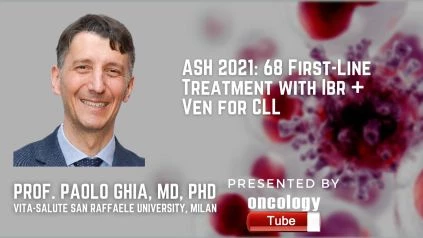Paolo Ghia received his MD from the University of Torino, Italy, and received his PhD working at the Basel Institute for Immunology, Switzerland, studying B lymphocyte development. Next, he studied the molecular mechanisms of the pathogenesis of chronic lymphoproliferative disorders, particularly of follicular lymphoma at the Dana-Farber Cancer Institute, Harvard Medical School, Boston.
Â
He is now working in Milano, as Professor of Medical Oncology at the Università Vita-Salute San Raffaele; and Deputy Chairman of the Division of Experimental Oncology, at the affiliated Hospital, where he is Director of the Strategic Research Program on CLL, including a dedicated unit for phase 1 studies.Â
Â
His research interest is the study of the molecular and cellular mechanisms acting in the natural history of Chronic Lymphocytic Leukemia (CLL), including Monoclonal B-cell Lymphocytosis (MBL). On these topics he has published over 300 manuscripts in peer-reviewed journals.
Â
He is President of the European Research Initiative on CLL (ERIC) and a member of the International Workshop on CLL (iwCLL). He coauthors the EHA-ESMO guidelines for CLL treatment and the ERIC recommendations on IGHV, TP53 and MRD analyses. He is currently Associate Editor for CLL at Hemasphere, the official Journal of the EHA.
Â
In this video, Dr. Ghia discusses First-Line Treatment with Ibrutinib (Ibr) Plus Venetoclax (Ven) for Chronic Lymphocytic Leukemia (CLL): 2-Year Post-Randomization Disease-Free Survival (DFS) Results from the Minimal Residual Disease (MRD) Cohort of the Phase 2 Captivate Study.
https://ash.confex.com/ash/2021/webprogram/Paper144544.html
Background: Ibr is a once-daily Bruton tyrosine kinase inhibitor that has showed a significant advantage in progression-free survival (PFS) and overall survival in various randomized phase 3 studies in first-line CLL. Ven, an oral BCL-2 inhibitor licensed for CLL treatment as a single drug or in combination with rituximab or obinutuzumab, has a high rate of undetectable MRD (uMRD). Ibr and Ven, which have different but complimentary modes of action, work together to mobilize CLL cells from lymph nodes and lymphoid niches, improve cell killing, and destroy specific CLL cell populations. CAPTIVATE (PCYC-1142; NCT02910583) is a multicenter, multinational phase 2 trial that compares first-line Ibr + Ven in two cohorts: MRD and Fixed-Duration (FD). Three cycles of Ibr were given to patients (pts), followed by 12 cycles of combination Ibr + Ven. In the MRD cohort’s primary analysis, patients with confirmed uMRD who were randomized to placebo or continued Ibr following a fixed-duration therapy had equal 1-year DFS rates (95 percent and 100 percent, respectively) after randomization (Wierda, ASH 2020). The results of a two-year post-randomization study are reported.
Methods: Pts with previously untreated CLL aged 70 years or older received three cycles of Ibr lead-in followed by 12 cycles of combined Ibr + Ven (oral Ibr 420 mg/day; oral Ven ramp-up to 400 mg/day). During cycle 16, patients with Confirmed uMRD (defined as uMRD in both peripheral blood [PB] and bone marrow [BM] serially during two evaluations three months apart) were randomized 1:1 to receive double-blind treatment with placebo or single-agent Ibr. Patients who did not fulfill the criteria for Confirmed uMRD were randomly assigned to open-label therapy with single-agent Ibr or continuous Ibr + Ven. The 2-year DFS rate (defined as survival without progression [PD] or MRD relapse post-randomization) in patients with confirmed uMRD randomized to placebo vs Ibr, rates of uMRD (10–4 by 8-color flow cytometry), investigator-assessed best response per iwCLL, investigator-assessed PFS, and adverse events are among the endpoints presented (AEs).
The total number of participants was 164. The average age was 58 years old (range, 28-69). Unmutated IGHV (60 percent of pts), del(17p)/TP53 mutation (20 percent), complex karyotype (19 percent), and del(11q) without del(17p) were all high-risk characteristics (17 percent ). After 12 cycles of Ibr + Ven, 149 participants were randomly assigned to one of two groups: confirmed uMRD (n=43) or Ibr (n=43); without confirmed uMRD (n=31) or Ibr + Ven (n=32). Overall, the median follow-up time was 38.2 months (range: 15.0-47.9), and the median post-randomization follow-up time was 24.0 months (range, 5.8-33.1). There have been no new DFS events in patients with confirmed uMRD who were randomized to placebo versus Ibr since the primary analysis; 2-year DFS rates post-randomization remained unchanged at 95 percent (placebo) vs 100 percent (Ibr), for a 4.7 percent difference (95 percent CI -1.6–10.9) and overall log-rank P=0.1573 (Figure 1). Following randomization, complete response (CR) rates in the placebo and Ibr groups, including CR with incomplete bone marrow recovery (CRi), showed modest improvements (Figure 2). PFS rates at 36 months were estimated to be 95% with placebo and 100% with Ibr. Post-randomization, in pts with Confirmed uMRD assigned to Ibr vs Ibr + Ven, Ibr + Ven showed higher improvements in best uMRD rates and CR/CRi rates than Ibr (Figure 2). With both Ibr and Ibr + Ven, estimated 36-mo PFS rates were 97 percent. All pts (N=164) had a median treatment duration of 36.8 months (range, 0.5-47.9). After randomization, there were minor variations in AEs across treatment arms. Neutropenia (36 percent), hypertension (10 percent), thrombocytopenia (5 percent), and diarrhea were the most common grade 3/4 AEs across all treated patients during the research period (5 percent ). AEs led to the termination of Ibr or Ven in 13% of patients after up to 48 months of treatment; no new safety flags arose.
Conclusions: In patients with CLL, first-line Ibr + Ven is an all-oral, once-daily, chemotherapy-free treatment that produces profound responses. With an extra year of follow-up and no new MRD relapses, PDs, or deaths in patients with confirmed uMRD, the 2-year DFS rate in the MRD-guided placebo arm remained high at 95%, while 3-year PFS rates in all randomized treatment arms were likewise high at 95%. The findings in patients with Confirmed uMRD support the possibility of treatment-free remission with fixed-duration therapy, even in those with high-risk characteristics. The safety profile of Ibr + Ven was consistent with the established safety profile for each agent, resulting in high rates of uMRD.

